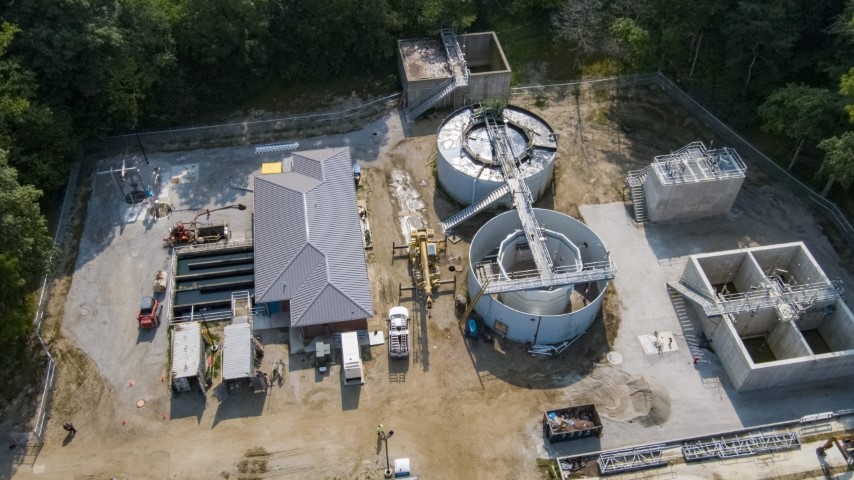Why retrofit your wastewater treatment system?
In the 1970s and 1980s, federal grants paid a majority of the costs to build or expand wastewater treatment plants. Many Publicly Owned Treatment Works (POTWs) constructed then had a lifespan of 40 to 50 years and have now reached the end of their service lives. Such wastewater treatment facilities face numerous challenges, including design inadequacies, limited treatment capacity, higher energy costs and the inability to meet effluent standards. Upgrading or replacing aging wastewater infrastructure is an obvious choice for the affected municipalities. However, since construction is often the most expensive option, retrofitting can be an economical alternative for wastewater treatment plants.
Below, we detail the reasons to retrofit a wastewater treatment plant in your community and how professional expertise can help you decide whether to replace or retrofit a treatment plant.
Replacing vs retrofitting your wastewater treatment system
Because of increasing urban and semi-urban populations, POTWs often struggle to treat the increased effluent volume, working beyond their design capacities. Changing treatment standards and effluent limitation guidelines also stretch a treatment plant's capacity.
Replacing and expanding POTWs to address contaminants and higher demand
To handle higher volumes of wastewater and comply with stringent effluent regulations, municipalities often consider expanding their wastewater infrastructure by building a treatment plant. Two factors that heavily influence a municipality's decision to replace a wastewater treatment plant are:
- Level of contaminants. Local industries such as processed food and metal manufacturing can increase the levels of Biochemical Oxygen Demand (BOD) or suspended solids and metals, including zinc, lead, iron and nickel, in wastewater. The quality of a plant's effluent determines which wastewater treatment technology the municipality must implement to comply with local effluent standards.
- Flow rate. The flow rate determines a plant's capacity because it must be able to treat the volume of wastewater produced. When a municipality plans a new or expanded wastewater treatment facility, it must consider the minimum recommended flow and loading conditions. If the per capita design flow is less than the recommended value, it may result in permit violation and hefty fines on the municipality.
Expanding the wastewater treatment plant requires standard components, including an oil/ water separator, a series of reactors, a clarifier, filtration equipment and a control panel. However, the actual makeup of the system requires more specific features and technology to meet local needs. Additional factors such as installation rates, operation costs, level of system automation, space requirements and construction make replacing a POTW with a new plant costly.
Retrofitting for increased efficiency and compliance
Newly designed POTWs incorporate the most effective, cutting-edge technology available. However, changing regulations and treatment environments can make a plant design obsolete quickly. As treatment objectives change, the resulting change does not necessarily require building a plant. Many municipalities choose to retrofit instead.
Retrofitting a wastewater treatment plant can benefit the affected municipality by:
- Improving treatment efficiency. Low-cost, high-impact improvements can increase the efficiency of a wastewater treatment plant. Increasing the performance of headworks processes, for example, can prevent the accumulation of bypassed sedimentation and debris downstream. This material drastically affects treatment efficiency of all downstream processes, the removal of which can significantly increase performance of downstream units without making any improvements to the units themselves. Retrofits that minimize structural changes are highly desirable for POTWs. Cost-effective solutions can protect what happens downstream and improve the overall efficiency of the plant. For example, worn-out screens at the headworks can be retrofitted with a mechanically cleaned screen, a manual bar screen and a grit-removal system.
- Meeting effluent standards. Effluent standards require the removal of excess nutrients, including phosphorus and nitrogen. Biological Nutrient Removal (BNR) is often the first choice for municipalities seeking to avoid the annual chemical costs associated with coagulant addition. However, retrofitting the treatment system with Integrated Fixed Film Activated Sludge (IFAS) can increase the efficiency of nutrient removal simply by adding media. The IFAS treatment is particularly suited for POTWs where space is limited and building tanks to increase the plant capacity is not possible.
- Saving money. Retrofitting equipment with energy-efficient alternatives can be more cost-effective over the life cycle of a POTW. For example, a reinforced concrete inflow pipe experiences corrosion over time and should be replaced with corrosion-resistant PVC. A cost-effective retrofitting option could be to leave the pipe in place but coat the interior with a plastic liner to prevent corrosion from sulfides. If the pipe's size still meets the projected demand, retrofitting can save significant costs.
However, retrofitting a wastewater treatment plant comes with its own challenges. Common complications include sequencing construction such that treatment continues throughout the project. Construction is comparatively easier to permit and build while meeting utility demands.
When upgrading a wastewater treatment plant or deciding between replacing or retrofitting a POTW, a municipality is often not equipped with the technical know-how to make the best decision. Teaming up with a wastewater engineering professional can help you make the right decision for your community's wastewater treatment infrastructure.
Deciding the best method for wastewater treatment for your community
What works as the best method for wastewater treatment for other communities might not work for yours. That is why it is critical to assess the contaminants present in the effluent stream of your local POTW through a wastewater treatability study and inflow/infiltration study.
The team of licensed engineers and operators at Fehr Graham can help you develop environmentally compliant and cost-effective solutions to improve the quality of wastewater effluents. Our expertise in inflow/infiltration studies, nutrient removal, collection system modeling, design and rehabilitation have assisted communities across the U.S. in upgrading their treatment systems.Are you in the middle of deciding how to retrofit the wastewater treatment plant in your community? Fehr Graham can help you find the right wastewater solution as well as source funds to implement it. Contact Us to learn more about our services or call 217.352.7688.
Collaborative, Insightful, Results-Driven Solutions
Fehr Graham provides innovative engineering and environmental solutions to help improve the lives and communities of our customers.


